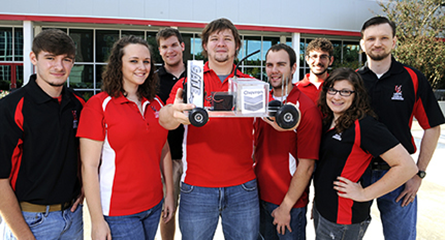It’s the size of a toy, but University of Louisiana at Lafayette students’ chemically powered car isn’t designed for child’s play.
The custom-made auto could fit in a shoebox, all right, but rolls on the strength of a lead acid battery. It stops via an “iodine clock” reaction detected with optical sensors.
It’s a Chem-E-Car, built by UL Lafayette chemical engineering majors, and it could go up in a poof of smoke at any second. Instead, it leaves most similarly styled cars sputtering in its dust.
The UL Lafayette team’s car placed sixth in the American Institute of Chemical Engineers competition recently in Pittsburgh, besting a 35-college field that included Ivy League and international schools. Cornell University took top honors, followed by the University of Puerto Rico-Mayaguez, Oklahoma State University, the University of Pittsburgh, the University of Houston and UL Lafayette.
Dr. William Chirdon, the UL Lafayette assistant professor of chemical engineering and the team’s adviser, said the event isn’t really a “race” at all but “a competition as to which team is the best at modeling chemical reactions and their vehicle’s performance.”
Chem-E-Cars must travel a set distance while hauling a payload of water. The course distance and cargo amount aren’t disclosed until one hour before competition. Students must tabulate the calculations needed to give the car some giddy-up-and-go and stop it as close to the finish line as they can without a remote control or timed braking mechanism. The whole deal has to unfold in under two minutes. “So distance travel has to be controlled by chemical reaction kinetics,” Chirdon said.
In logging its strong showing, the UL Lafayette team flexed more than intellectual muscle. Students are also tasked with standing up to the pressure of passing face-to-face interviews and meeting the requirements of rigorous inspections. “The safety rules alone are 16 pages,” Chirdon said, adding the UL Lafayette team also overcame adversity. The airline lost a poster mandatory for a safety evaluation, and luggage handlers damaged the car’s circuit board, designed by a student who had graduated in the spring. “So, upon arrival, the team had to reconstruct the poster, teach themselves the fundamentals of circuits online, and then proceed to repair the circuit board,” he said.
UL Lafayette’s Chem-E-Car was also constructed economically. While some entries cost nearly $2,000, UL Lafayette’s vehicle was built with about $75 in materials.
“There is certainly a lot of pride in finishing sixth in this prestigious national competition,” Chirdon said.
Student members of the Chem-E-Car team include: Forest Kidder (captain), Gabby Anderson, Timothy Boudreaux, Cassie Drexel, Brandon Plaisance and Eric Regel. Team members Aaron Brocksmith and Marshall McDaniel were unable to attend the conference. Seniors who worked on the car in the spring include: Caleb Breaux, Trey Romero, Jordy Mitchell and Dru Vitale, an electrical engineering student.
After several years of regional competition, this semester marks the first time UL Lafayette has reached the national competition, part of the AIChE’s Annual Student Conference. The team competed in the Southern Regional AIChE Student Conference earlier this semester in Clemson, S. C.
“Each year, our performance in regionals improved until the spring of 2012, when we qualified for the national competition,” Chirdon said.
Photo: From left, front, Timothy Boudreaux, Gabby Anderson, Forrest Kidder, Eric Regel, Cassi Drexel and Dr. William Chirdon;back, Aaron Brocksmith, Brandon Plaisance.
